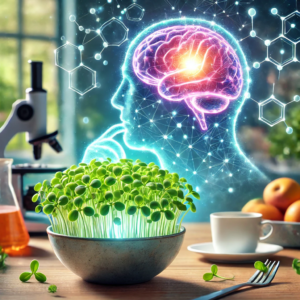
Alzheimer’s disease, a progressive neurodegenerative condition, remains one of the most significant health challenges today. While genetics play a crucial role in its onset, lifestyle and diet are emerging as modifiable factors influencing disease progression. Among dietary interventions, microgreens—tiny, nutrient-dense versions of mature vegetables and herbs—are gaining attention for their potential role in cognitive health and Alzheimer’s prevention.
What Are Microgreens?
Microgreens are young vegetable greens harvested shortly after the first leaves appear. Though small, they pack a powerful nutritional punch, often containing 4–40 times higher levels of vitamins and antioxidants compared to their mature counterparts. Key nutrients in microgreens—such as vitamins C and E, beta-carotene, and polyphenols—are known for their neuroprotective properties.
The Science Behind Microgreens and Alzheimer’s
Alzheimer’s is characterized by oxidative stress, neuroinflammation, and the buildup of amyloid-beta plaques in the brain. Microgreens, thanks to their dense nutrient profile, target several of these underlying mechanisms:
Combatting Oxidative Stress: Oxidative stress is a major driver of Alzheimer’s progression. Microgreens like broccoli and kale are rich in sulforaphane and glucoraphanin, compounds shown to enhance cellular antioxidant defenses. A 2022 review highlights how these compounds activate Nrf2, a protein that regulates protective enzymes to counteract oxidative damage. (Jambor et al., 2022).
Reducing Neuroinflammation: Chronic inflammation exacerbates Alzheimer’s by accelerating neuronal damage. Microgreens contain bioactive polyphenols, such as quercetin and luteolin, that modulate inflammatory pathways. Research in Food & Function demonstrates that these polyphenols can significantly reduce neuroinflammation. (Teng et al., 2021).
Boosting Brain Plasticity: Flavonoids found in microgreens improve neuroplasticity—the brain’s ability to form new neural connections. Spinach and red cabbage microgreens, rich in anthocyanins, are especially effective in supporting memory and learning. This was confirmed in studies on their bioactive properties. (Nowicka et al., 2020).
Supporting Gut-Brain Health: The gut-brain axis is increasingly recognized as a critical factor in Alzheimer’s. Microgreens, with their prebiotic fibers and phytochemicals, support a healthy gut microbiome, reducing systemic inflammation and improving gut-brain communication. This role has been emphasized in reviews linking microgreens to improved cognitive health. (Datta et al., 2022).
Incorporating Microgreens into Your Diet
Microgreens are versatile and easy to integrate into daily meals. Add them to salads, sandwiches, smoothies, or soups. Varieties like broccoli, arugula, red cabbage, and sunflower microgreens are particularly beneficial for brain health. Their vibrant flavors and textures also make them a delightful addition to any dish.
Future Perspectives
Though promising, research on microgreens and Alzheimer’s is still emerging. Further clinical trials are needed to confirm their efficacy in human populations. Nevertheless, existing evidence strongly supports their role as a functional food capable of addressing multiple pathways involved in Alzheimer’s progression.
Integrating microgreens into your diet is not only a flavorful choice but also a proactive step toward better brain health. As science continues to uncover their potential, these tiny greens could become an essential tool in the fight against neurodegenerative diseases.
References
- Jambor, T., Knizatova, N., Valkova, V., & Tirpak, F. (2022). Microgreens as a functional component of the human diet: A review. Journal of Microbiology, Biotechnology, and Food Sciences. Read here.
- Teng, J., Liao, P., & Wang, M. (2021). The role of emerging micro-scale vegetables in human diet and health benefits. Food & Function. Read here.
- Nowicka, P., Turkiewicz, I. P., & Wojdyło, A. (2020). Sprouts vs. microgreens as novel functional foods: Variation of nutritional and phytochemical profiles. Molecules. Read here.
- Datta, S., Rai, U., & Rai, S. (2022). Microgreens: A superfood for nutritional security in the 21st century. ResearchGate. Read here.
